These days multi-FX pedals do more than just add a stompbox to your rig. With a focus on modeling, most of the best multi-effects pedals can not only augment your existing setup but completely replace it.
Multi-effects have traditionally been seen as a bastion for beginner guitarists, something to help them find their way before upgrading to a ‘proper’ stompbox.
But thanks to the incredible advancements in digital modeling, more and more guitarists are looking to multi-effects for their home, recording, and live setups.
10 Best Multi Effects Pedals for 2025
1. HeadRush CORE Guitar and Vocal Processor
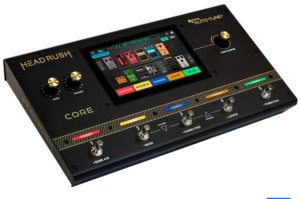
The HeadRush CORE is more than just a pedal; it’s an all-in-one powerhouse. It boasts a range of effects and amp models, offering vintage classics, modern masterpieces, and everything in between.
It also has five customizable footswitches, each with its own colored LED. And it’s not just for guitars. It’s also a vocalist’s helper. For vocalists, there’s a full suite of vocal FX, including Antares Auto-Tune.
One of the most notable features is the Amp Cloner, which captures the sonic characteristics of your favorite analog gear, including amps, pedals, or microphones.
This allows you to capture all the sounds and dynamics of some seriously iconic gear in a versatile and streamlined setup.
I also love the looper that comes with CORE. It can capture up to 5 minutes of loop length per loop and 20 minutes of total audio, and you can easily save and load those loops at any time.
HeadRush CORE also lets you sync the looper to other devices, such as drum machines, via MIDI.
Even better, CORE’s rugged, portable design means you’re always ready to hit the road. The user-friendly 7-inch touchscreen interface makes tweaking your tone as easy as plucking a string.
Connect your amp, mixer, headphones, whatever you want. Just plug it into CORE. It can also be used as a USB audio interface to record directly from your Mac or PC.
2. Line 6 HX Stomp
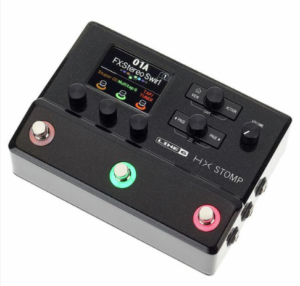
The HX Stomp is a compact solution for those looking for a budget-friendly boxed rig, or those who’ve been eyeing the full-fat Helix but want something smaller and simpler.
The HX Stomp is truly amazing. With over 300 effects, including all the classic Line 6 patches, Helix, and M series effects, you won’t be able to find the sound you’re looking for.
It also has the same amp models as the full-size Helix.
We found it a bit tricky to program because of its small size, but Line 6’s HX Edit software provides a pretty straightforward editing platform if you have the time to plug in the HX Stomp.
Honestly, the slight fiddling isn’t a big deal when the pros far outweigh the cons.
3. Boss GX-100
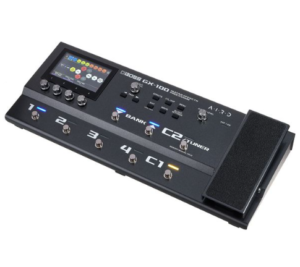
If you’re a pedal enthusiast, Boss is a familiar name to you. Their compact stompboxes are endlessly popular, but their multi-effects units haven’t gotten the same response.
As a result, the new GX-100 looks like it has a point to prove right out of the gate, and it certainly does.
The GX-100 is Boss’ first pedal to include a touchscreen, and hopefully not the last.
Setting up patches and presets on the GX-100 is a much easier, more streamlined, and more beginner-friendly process than other Boss pedals, and editing parameters is equally simple and intuitive.
We still consulted the manual occasionally, but getting to grips with the GX-100 is a satisfying and straightforward process.
The GX-100 has a few amp models that cover most tonal bases, but it’s the vast array of onboard effects that really shine.
All 154 of them sound great before you even start tweaking them, and they get even better as you tweak and stack them.
Considering the possibilities of the GX-100, whether as a standalone modeling amp, a multi-effects device that plugs into a tube amp, or a MIDI-switching blend of the two, this device is incredibly affordable and easy to use.
4. HeadRush PRIME Guitar and Vocal Processor
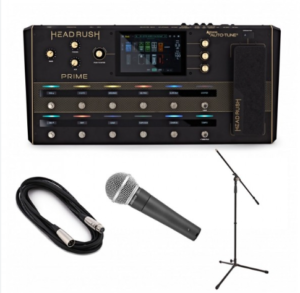
The HeadRush PRIME Guitar and Vocal Processor is a professional-grade secret weapon, the perfect all-in-one solution for guitar and vocals.
Tailored for singer-guitarists and multi-instrumentalists, PRIME offers additional switches for expanded control and a built-in expression pedal to add even more polish to your sound.
What sets PRIME apart is its incredible versatility. Boasting an extensive library of effects and amp models, you can use both vintage sounds and more modern effects, or create your own signature sound.
Guitarists can explore a wide range of effects and amp models, while vocalists can completely transform their voices.
And to ensure you get the exact sound you want, PRIME’s built-in cloning system has you covered.
Simply plug in your favorite amp or pedal, follow the on-screen instructions, and the device will take a digital snapshot of that sound and give you a clone that you can tweak to your liking.
You can even download clones from other musicians and share your own clones via the HeadRush cloud!
Thanks to the intuitive touchscreen interface, navigating PRIME’s features is a breeze. You’ll find your way around without a manual. Simply tap, swipe, and dial in the tone of your dreams with ease.
PRIME is also built to last. The rugged, compact design is designed to withstand the shocks and impacts of touring, making it the perfect companion for the performing musician.
HeadRush PRIME integrates seamlessly into your setup, offering a variety of connectivity options to suit your unique needs.
Easily connect to your amplifier, mixer, headphones, or other gear. Designed to fit your playing environment, it’s a versatile addition to your musical arsenal.
5. Boss GT-1000 Guitar Multi-Effects Pedal
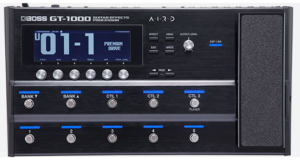
The BOSS GT-1000 is a powerful multi-effects pedal featuring AIRD Tube Logic technology, 116 effects, 10 footswitches, and an expression pedal.
It allows for computer-based recording and editing via a USB/audio interface. Comes with an original tote bag.
The Boss GT-1000 Guitar Multi-Effects is a versatile and powerful multi-effects pedal designed for guitarists seeking a variety of high-quality sounds and effects.
Featuring advanced AIRD Tube Logic technology, the GT-1000 delivers outstanding sound quality and realism, emulating a wide range of American and British amplifiers with impressive accuracy.
This multi-effects pedal offers 116 effects, including a comprehensive collection of Boss’ signature effects.
Ten footswitches and an expression pedal allow users to easily explore and control their sounds, making it ideal for live performances, studio sessions, or home practice.
The GT-1000 also functions as a USB/audio interface, allowing for seamless computer-based recording and editing. Plus, this powerful pedal comes with an original tote bag for easy transport.
6. TC Electronic Plethora X5
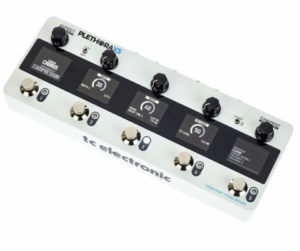
The TC Electronic TonePrint pedals have always offered a wide range of effects that can be customized at a very reasonable price.
With the TC Electronic Plethora X5, the team has created a sort of TC Greatest Hits tour, bringing together each pedal in the TonePrint line.
The Plethora X5 lets you chain up to five TonePrint pedals from a list that includes Flashback, Hall of Fame, Corona, Vortex, and more.
You can arrange them in any order you like, but you might run into limitations with the DSP if you’re trying to stack five reverbs or delays, for example.
These configurations can be saved as ‘scenes’ and recalled whenever needed. Since its release, TC has added additional pedals via firmware, making this a great, compact solution with huge creative potential.
7. Boss GT-1000 Guitar Effects Processor
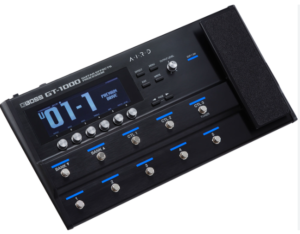
The Boss GT-1000 guitar effects processor is all about great sound.
Featuring cutting-edge effects, amp models, and Boss’ groundbreaking AIRD (Augmented Impulse Response Dynamics) technology, this technology takes the device to the next level.
It doesn’t just replicate classic amps and effects; it captures their dynamic responses for incredible realism.
The pedal offers a wide range of connectivity options with a variety of input and output options, allowing it to integrate seamlessly with your PA system, amp, or recording interface.
Plus, the GT-1000 remains user-friendly despite its extensive feature set, thanks to its intuitive design and large, easy-to-read display. Sculpt your ideal tone at your fingertips.
With Boss’s renowned ruggedness and a wide range of connectivity options, the GT-1000 is ready to handle live performances and studio sessions, making it a reliable companion for years to come.
8. HeadRush MX5
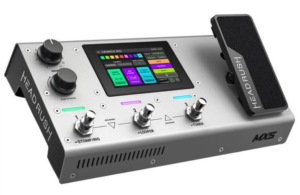
Following the acclaimed PedalBoard, HeadRush’s MX5 aims to pack all that processing power into a device that can fit in front of your gigabyte.
Don’t be fooled by the small size of this excellent multi-effects pedal, which features beautifully detailed amp models, a variety of FX, and an expression pedal.
The emulated amp sounds are incredibly detailed and realistic. They interact well with your playing dynamics, making them feel satisfyingly real.
The effects department also shines, especially the reverb and delay. It delivers a very appealing, realistic three-dimensional sound.
Overall, the device is easy to use, and the intuitive touchscreen gives you plenty of great options for tweaking your tone on the fly.
You can easily run multiple pedal chains, quickly switch between presets, or edit and save specific parameters. Whatever you need to do, you’ll never need to look at a manual again, thanks to the display.
9. Boss GX-100 Guitar and Bass Effects Processor
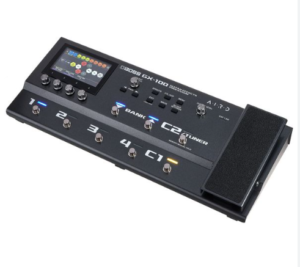
The Boss GX-100 Guitar and Bass Effects Processor is a true game changer for musicians seeking top-notch sound quality and unrivaled creative possibilities.
This pedal focuses on sonic excellence, boasting 24-bit AD and 32-bit DA conversion, 32-bit floating point processing, and a 48kHz sampling rate, ensuring exceptional sound.
The secret to its performance lies in Boss’s exclusive AIRD (Augmented Impulse Response Dynamics) technology.
This innovation not only replicates but encapsulates the true response of classic amps and effects into a compact, reliable unit.
Featuring 23 amp types and over 150 BOSS effects, the GX-100 is a treasure trove of tonal versatility.
With 15 assignable blocks for flexible amp and effects routing, you can create the sounds of your dreams.
It also offers a variety of onboard speaker types and the ability to load WAV speaker IRs via USB, providing endless tonal possibilities.
The color touch display and modern design allow for intuitive navigation of the extensive functionality.
Eight user-definable footswitches and expression pedals provide real-time control and are configurable to meet your unique needs.
You can also explore external control options via footswitch, expression pedal, or MIDI.
The pedal’s solid and durable construction ensures that it can handle both stage and studio demands. It’s a must-have for serious musicians looking for a creative and versatile live and recording setup.
10. Eventide H9 Max
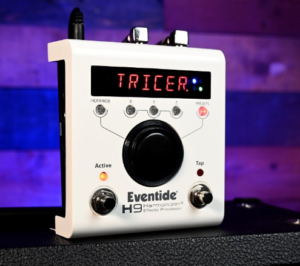
The H9 is one of the best pedals available and can fill multiple roles on your pedalboard. The H9 Control app makes it easy to adjust parameters and the software can be updated to keep it future-proof.
The Eventide H9 is simply amazing. It’s practically an entire pedalboard in a single stompbox, so it can fill virtually any role.
Eventide has been putting rack-grade effects in their pedals for years, but the H9 Max takes it to a new level.
Eventide has made algorithms from other Eventide products like Space, PitchFactor, ModFactor, and TimeFactor available on the H9, and they’ve also released a few effects that are exclusive to the processor.
The H9 features a large central wheel that scrolls through the 99 factory presets.
The large knobs, combined with the large, bright display, make navigating the H9 intuitive with so many tonal options.
You can also use the right footswitch to scroll through the presets, or tap tempo. Once you find the preset you want to select, press the left-foot switch to activate it.
If you want to adjust something on the fly, there are three variable buttons that let you adjust parameters.
Simply press one of the variable buttons, and the LEDs around the knob will light up to indicate the parameter level. Turn to adjust the parameter to your liking.
The H9 features true stereo inputs and outputs, an expression pedal input, a mini USB port, and MIDI in and out.
Eventide’s H9 Control software, available free on the Eventide website for iOS, Mac, Windows, and Android, is incredibly simple to use and offers extensive EQ options in a useful, intuitive way.
Factory and custom presets are also easy to save and export to the H9 via Bluetooth.
The H9 Control app for iOS is incredibly intuitive and full-featured. Once you start playing with the H9 Control, you’ll quickly become addicted.
There are currently 51 effects algorithms and over 500 presets available through the H9 Control. They’re consistently excellent.
Whether you choose to customize your setup from your laptop or phone, I can’t overstate how convenient Bluetooth connectivity is on the H9.
11. Fender Tone Master Pro
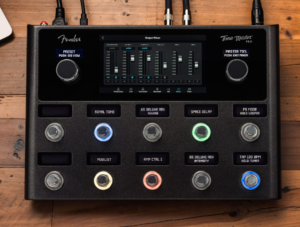
The Fender Tone Master Pro is an innovative multi-effects guitar workstation that lives up to the exceptional sonic standards set by the Tone Master series.
It combines this renowned sonic quality with a user-friendly interface and the most comprehensive I/O array available.
With over 100 of the world’s most popular amps and effects, including classic Tone Master Fender models and the officially licensed EVH 5150 III Stealth model, the Tone Master Pro leaves no sonic stone unturned.
What sets this product apart is Fender’s exclusive Tone Master Modeling process, which perfectly replicates these iconic tones.
Featuring a full-color touchscreen for easy navigation and quick parameter adjustments, it simplifies your journey to finding that perfect tone.
Tone Master Pro doesn’t just replicate tones; it also lets you easily create, customize, and configure your sounds.
Ten customizable footswitch encoders allow for seamless editing, instant access to presets and parameters, and realistic adjustments.
Connecting to the Tone Master Pro Control app via USB opens up a world of possibilities, from creating and editing presets to downloading thousands of tones from Fender’s community of artists and players.
This multi-effects workstation is a versatile powerhouse, featuring a 60-second stereo looper, four effects loops, instrument and XLR mic inputs, and Bluetooth wireless connectivity for streaming audio from your mobile device.
It’s not just a stage companion. It can also be used as a USB audio interface for recording and performing with your computer.
The Tone Master Pro is the ultimate choice for guitarists seeking unparalleled sound quality, versatility, and ease of use in a single, powerful package.
12. Mooer GE300
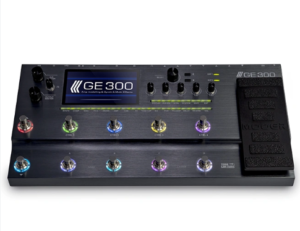
Mooer is a relatively new entrant into the multi-effects world but has certainly made an impact at a variety of price points. The GE300 is a great value for money, and while it’s not a ‘big’ brand, it’s definitely worth a look.
The Mooer GE300’s 164 onboard effects are just the first of many impressive features, putting many extensive pedalboards and other multi-effects systems to shame.
Combine these effects with 108 preamps and you’ve got all the makings of a great amp modeler, and you can even model your own amps with Mooer’s Tone Capture software.
If that weren’t enough, the GE300 also includes 43 speaker cabinet models, a 30-minute (yes, 30-minute) loop station, and a seriously awesome synth engine that turns any guitar into a synth without having to lug around MIDI cables or install any special pickups.
A programmable FX loop with optional signal chain routing is just one of many additional features that make the GE300 a great choice for anyone looking to save money.
13. Line 6 Helix-LT Streamlined HX Guitar Effects Processor
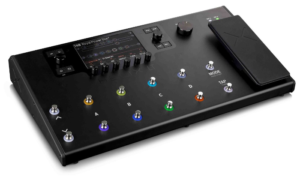
The Helix LT guitar processor delivers class-leading performance, flexibility, and control.
Featuring the same powerful dual DSP processing and award-winning HX modeling technology found in the flagship Helix Floor and Helix Rack guitar processors.
The streamlined I/O complement and hardware configuration still makes it more affordable for budget-conscious guitarists who want to access the power of Helix.
The Helix LT is also the ideal backup processor for Helix Floor and Helix Rack owners, as the presets for all three are compatible.
The Helix guitar processor represents a huge leap forward in modeling technology.
The dual DSPs provide tremendous power to accurately reproduce the sonic character and full dynamic response of classic and modern amps and effects.
The Helix HX Hybrid cabinet included with the Helix LT processor represents a new approach to the speaker cabinet capture process.
It delivers the same resolution and low-end accuracy as a 2048+ point impulse response while using only about the same amount of DSP power as a 1024-point IR.
A choice of 16 different microphones and 12 recording distances provides additional sonic flexibility and real-time dynamic control.
The Helix LT processor also allows you to load custom impulse responses to further personalize your rig.
14. Boss GT-1000
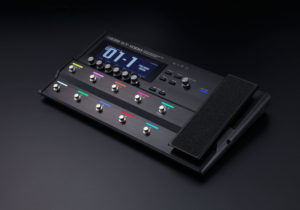
Boss’ GT series of multi-effects are as old as time itself, but the GT-1000 seems to be from the future.
The 1000 is portable, powerful, and incredibly durable, making it a reliable Boss option for anyone looking for a solid, high-quality guitar tone.
The GT-1000’s multi-effects capabilities are truly extensive, with over 145 different types of effects to choose from.
Boss’ most impressive pedals of late have been the 500 series, so it’s no surprise that you’ll have access to all of them within the GT-1000.
In most cases, you’ll need more than studio-quality delays, modulations, and reverbs, but Boss isn’t done there.
AIRD technology simulates the complexities of modern and vintage tube amps, as well as the air behavior around the cabinet, so you can expect truly high-fidelity tones.
Boss has developed a new DSP engine that, with a 96kHz sample rate, delivers better tone quality than studio-quality, and Boss’s unique multi-dimensional programming responds to how you play rather than what you play, making the GT-1000 an ideal choice for gig or bedroom guitarists.
Conclusion
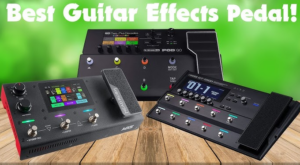
In short, the world of multi-effects pedals is vast, with options ranging from affordable options to powerful, feature-packed units.
The best multi-effects pedal for you will depend on your specific needs. Whether you’re a beginner, a seasoned pro, or somewhere in between, there’s a multi-effects pedal out there for you.
These versatile devices have come a long way in replacing cumbersome pedalboards, and can even emulate entire rigs.
FAQs
How many effects do I need?
Multi-effects pedals vary in the number of effects they offer, so it’s important to consider the specific effects you need for your style of music.
If you’re a guitarist who uses a variety of tones, make sure your multi-effects pedal offers all of them!
However, if you’re focused on your sound, a simple pedal with core effects may suffice. Make sure the pedal you choose includes the specific effects you use most often, such as distortion, delay, reverb, modulation, and more.
What is a guitar effects pedal, really?
An effects pedal is just a small electronic box with a knob. Instead of plugging your guitar into an amp, you plug it into an effects pedal and then run a second cord from the pedal to the amp.
An effects pedal changes the sound of your guitar in some way. You can add fuzz to your sound, add a nice echo, or add a funky wah effect.
There are dozens of possibilities (and thousands of different models being made today). Effects pedals basically make your guitar sound better, and usually more professional.
What should you look for in a multi-effects pedal?
If there’s one thing to consider when choosing the best multi-effects pedal for you, it’s the wide range of choices.
As with everything, your budget will determine which end of the spectrum you end up at, but there are plenty of choices, from massive “studio-in-a-box” type units to small form factor pedals that pack a few essential effects into your pedalboard.
If there’s one thing I believe about learning guitar, it’s that it should be fun. I keep telling people this, but beginners will always get much better when they really enjoy playing the guitar.
When new players really enjoy playing, they play more often. I don’t have to tell you, but it makes them much more fun than those who have to drag themselves to the instrument.
Guitar effects pedals aren’t necessary to play guitar, but for many players, especially beginners, they make it a lot more fun.
For some parents, they can make the difference between dragging their kids to practice and putting them to bed with their guitar.
What is a guitar effects pedal?
An effects pedal is just a small electronic box with a knob. Instead of plugging your guitar into an amp, you plug it into an effects pedal and then run a second cord from the pedal to the amp.
An effects pedal changes the sound of your guitar in some way. You can add fuzz to the sound, add a nice echo, or add a funky wah effect.
There are dozens of possibilities (and thousands of different models currently in production). Effects pedals basically make your guitar sound better, and usually more professional.
How much do they cost?
They range in price but generally range from about $30 (for an incredibly good unknown brand) to $100 (for a big-name pedal).
Of course, the world is such that you can buy much more expensive boutique pedals (including pedals that cost hundreds of dollars and have long waiting lists). But they’re definitely not necessary for beginners.
In fact, I’d start this list with an $80 pedal that has dozens of built-in effects. This pedal can do everything, and it even includes a guitar tuner.
If you’re on a budget, this is an incredible value, and it’s hard to recommend anything else to a beginner.
Can you use effects pedals on an acoustic guitar?
If you have an acoustic guitar with pickups built in, you can, but if you don’t, you can’t really use them.
However, if your guitar has pickups (and many acoustic guitars do these days), adding effects can be a great and very satisfying sounding addition. Especially effects like delays and reverbs, echoes, etc.
How much is too much?
We’ve all seen examples of someone turning on a multi-effects rig and blasting presets like a kid in a candy store, but it’s really important to consider the types of effects you’ll actually be using.
Be realistic with yourself, because you’ll likely be content with a handful of the best guitar effects out there.
Would you be better off finding a smaller, more powerful rig that can handle the effects you use the most? Or do you absolutely need a giant spaceship-like rig full of weird sounds?
The alternative theory is that sometimes you’ll stumble upon something you’ve never used before and it’ll spark your creativity.
This definitely happens, and the happy side benefit of having as many effects at your disposal is that for beginners, the sub-$200 range offers plenty to get you excited.
If your goal is to pack as many effects as possible into one box, you’ll find plenty of options to choose from at all ends of the price spectrum.
From budget options like the tiny Zoom pedal to entry-level versions of pro models from big names in the effects space like Boss and Line 6.
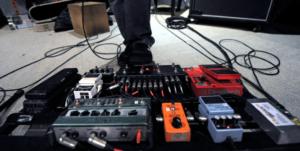
Is a multi-effects pedal worth it?
It all depends on what you value in your guitar. Many guitarists prefer a traditional pedalboard layout.
You can adjust each pedal individually without having to navigate through menus, rearrange them to your liking, or swap them out whenever you feel something isn’t working right.
However, with a multi-effects unit, there is less chance of bad patch cables or a failed pedalboard power supply, there is less to carry around, and they are generally cheaper than individual pedals.
In terms of sheer value for money, I would argue that a multi-effects pedal is worth the investment. Even if you sacrifice some ease of use, you can get a lot more out of a multi-effects pedal.
Which is better, a pedal or a multi-effects pedal?
Multi-effects pedals are generally considered a better option than individual pedals.
They save you the hassle and expense of building and arranging a proper pedalboard, and they don’t require complicated cables or power supply setups.
What should you look for in a multi-effects device?
If you’re just starting out on your guitar-playing journey, a multi-effects pedal is the perfect entry point into this vast world of sound.
Having such a wide range of sounds at your fingertips can be a huge help in focusing on your favorite sounds, and many multi-effects pedals come with presets that emulate the sounds of famous guitar players to get you started.
For players who already know what sounds they like, a multi-effects pedal can help you downsize your rig, making it easier to gig and complementing a pedalboard you’ve already assembled.
Mixing them with a regular stompbox is a great way to create a hybrid pedalboard that lets you take full advantage of both digital and analog effects.
It’s not just old stompboxes that can be replaced with multi-effects pedals. Most multi-effects pedals come with some sort of amp and cabinet simulation, so you can forgo the amp altogether and pack your entire rig in a gig bag and take it to your next gig!
You might hear tone purists squawking in the background, but for a world-weary guitarist who’s spent years lugging a heavy tube amp across the country, the idea of reducing your entire rig to a single device is certainly appealing.
Are multi-effects better than individual pedals?
Guitarists have debated forever whether multi-effects pedals are better or worse than individual pedals. Honestly? The answer is still unclear.
There are compelling arguments for and against each camp, but there are a few factors you should definitely consider before buying one of the best multi-effects pedals.
Firstly, multi-effects make gigging a lot easier because all your pedals and guitar effects are in one place and on one device.
Sure, you could buy a pedalboard and create a fancy “board” full of cool effects, but it’s not as convenient as having your entire gear and effects collection in one device.
The tones you can create with just a Helix or Kemper will sound much cleaner and more precise, with less background noise and buzz.
One of the great things about multi-effects and amp modeling is that you can go straight to your PA system when you’re on stage, eliminating the need for speaker cabinets on stage and significantly reducing back pain.
As long as the sound guy doesn’t hate you, you’ll have no trouble getting the exact tone you want in the room for everyone to enjoy.
Should I Buy a Floor Modeler?
You’ve probably heard the term “floor modeler”. That’s because floor modelers are all the rage among guitarists right now.
In addition to mimicking amps and effects, floor modelers are extremely advanced multi-effects pedals that boast tons of features and routing options, allowing you to pack all your gear in your bag and head to the next gig.
This may sound great, but many floor modelers can be overwhelming for inexperienced players, and you’ll spend more time navigating menus and tweaking tones than actually playing.
So while advanced floor modelers are great, if you’re just starting out and experimenting with sounds, you might want to wait for something simpler.
If you’re a regular gigger who’s replacing your entire rig, you’ll want to think about monitoring.
If you’re relying on a 30-year-old floor wedge to provide solid guitar tones at your local gig, you’re not going to get very far. Trust us on that.
So if you’re going this route, you’ll want to look into FRFR speakers that will give you a perfect mix on stage or in your rehearsal room.
